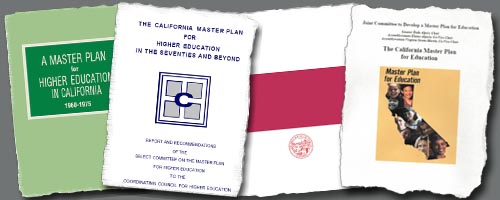|
|
Like today, in 1960 California higher education consisted of community colleges, state colleges, and state universities. Yet these three types of campuses suffered from disorganization, competition, and repetition. Moreover, the UC regents anticipated a tidal wave of baby boomer students would flood the state’s higher education campuses between 1960 and 1975. In the late 1950s University of California President Clark Kerr sought to address these problems by developing the California Master Plan for Higher Education.
The Master Plan’s principle concern was access, but it also wanted to organize the state’s three-tiered system. The Master Plan guaranteed the top 12.5% of graduates a spot at one of the UC campuses, the top 33.3% a spot on one of the California State campuses, and all had access to the community colleges with the ability to transfer to a four-year campus. Opportunity and hierarchy were both build into the plan. The Master Plan envisioned a community college within driving distance of every student, but only allowed the UC to grant PhDs. It was a plan based on vision and practicality: it would make California a pioneer for higher education and at the same time save taxpayer’s money by establishing a distinct mission for each type of campus.
The Master Plan continues to serve as an ideal for which California continues to aspire. Since 1975 the Master Plan has been reviewed and renewed to address present concerns. The 1987 and 2002 renewals focused on the state’s changing demographics and the challenges inherent in guaranteeing access for every student in a state with a rapidly growing population that is increasingly diverse. The 1987 renewal emphasized diversity as an asset for California and central to fulfilling the aims of the Master Plan:
California has a population that is exceedingly rich in ethnic and cultural diversity. This diversity is a resource that must be carefully and sensitively developed to ensure the continued success of our state as a society and as a world leader.
The Master Plan remains a blueprint for California that must be flexible amidst a changing population.
While the 1960 Master Plan developed ways to get high school graduates to university campuses, and the 1987 and 2002 renewals revised the Master Plan to consider increased diversity, the plan did not provide any guidance for developing campus communities. As California added more campuses across the state, as population increased, and as the state grew more diverse, incidents of incivility increased and the university administrations had to develop ways to foster civility on campus.
The Master Plan remains an ideal to aspire to for California education. Protesters cite the promise of the Master Plan in contests over budget cuts, Chancellors reference the Master Plan to inspire excellence on their campuses, and politicians draw on the Master Plan to implement changes in higher education. Fifty-one years old, the Master Plan represents a challenge to California: How can the state fulfill the goals of the Master Plan?

|



